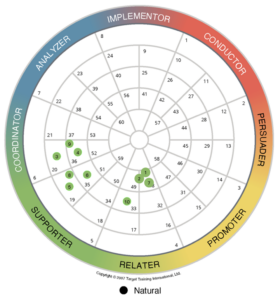 In today’s diverse workplace, understanding team dynamics is crucial for effective leadership. Recently, a client in Australia reached out with an intriguing question about their leadership team’s Leading From Your Strengths assessment results. This case study provides valuable insights into interpreting Leading From Your Strengths data and leveraging it to enhance team performance.
In today’s diverse workplace, understanding team dynamics is crucial for effective leadership. Recently, a client in Australia reached out with an intriguing question about their leadership team’s Leading From Your Strengths assessment results. This case study provides valuable insights into interpreting Leading From Your Strengths data and leveraging it to enhance team performance.
The Scenario
The client, leading a large church in Australia, shared Leading From Your Strengths results for a team of ten members. The data revealed a striking homogeneity in styles, prompting questions about cultural influences on assessment responses and the implications for team effectiveness.
Key Observations
- Style Clustering: The team showed a strong preference for Supportive, Coordinating, and Analyzing styles.
- Problem-Solving Approach: Most members leaned towards Reflective problem-solving.
- Change Management: There was a clear tendency towards Predictable change management.
- Limited Diversity: The team lacked representation in Promoting and Relater styles, with few members showing preferences for Optimistic change management or risk-taking.
Interpreting the Results
While Leading From Your Strengths is designed to measure individual preferences rather than cultural traits, it’s essential to consider potential cultural influences on assessment responses. In some cultures, there may be a tendency to provide answers perceived as more agreeable or expected.
However, the homogeneity in styles could also result from a common phenomenon in leadership teams: the unconscious, or conscience, gravitation towards individuals with similar styles. This can lead to a lack of diversity in perspectives and approaches, potentially impacting the team’s overall effectiveness.
The Double-Edged Sword of Homogeneity
A team with similar styles can have both advantages and drawbacks:
Advantages:
- Enhanced harmony and cohesion
- Efficient decision-making within the preferred style
- Shared understanding and communication
Drawbacks:
- Limited perspectives on problem-solving
- Potential blind spots in decision-making
- Reduced adaptability to diverse situations
- Difficulty in relating to a diverse workforce or client base
Recommendations for Maximizing Team Potential
- Open Discussion: Facilitate a team dialogue about the Leading From Your Strengths results. Explore how collective strengths serve the organization and identify areas where different perspectives could add value.
- Develop Complementary Skills: Encourage team members to stretch beyond their comfort zones. Provide opportunities for developing skills associated with less represented styles.
- Strategic Recruitment: When expanding the team, consciously seek individuals with complementary styles to broaden the team’s overall perspective.
- External Input: Regularly seek input from individuals outside the leadership team who bring different perspectives. This could include employees from various levels, external advisors, or even clients.
- Rotate Responsibilities: Assign team members to roles that require them to utilize less dominant styles, promoting personal growth and team adaptability.
- Cross-Cultural Training: Invest in cross-cultural communication training to enhance the team’s ability to understand and leverage diverse perspectives.
- Reassess Regularly: Conduct Leading From Your Strengths assessments periodically to track changes in team composition and individual growth.
The Value of Diversity
Diversity in a team extends beyond cultural background—it encompasses a range of perspectives, problem-solving approaches, and leadership styles. A well-rounded team is better equipped to:
- Embrace change and innovation
- Take calculated risks
- Engage in dynamic, fast-paced problem-solving
- Connect with and relate to a diverse workforce or client base
Conclusion
The Leading From Your Strengths assessment is a powerful tool for understanding team dynamics, but its true value lies in how organizations apply these insights. By recognizing the strengths and potential blind spots in team composition, leaders can take proactive steps to build more balanced, adaptable, and effective teams.
Remember, the goal isn’t to drastically change individual styles but to create an environment where diverse strengths complement each other. By embracing and nurturing diversity in thinking and approach, teams can unlock their full potential, driving innovation and success in today’s complex organizational landscape.
Raw Data:
| Natural Wheel Placement | Problem Solving | Processing Information | Managing Change | Facing Risk | |||||||
| Natural Style | Natural Style | Natural Style | Natural Style | ||||||||
| Promoting Relater (across) | 9 Reflective | 10 Optimistic | 10 Predictable | 9 Structured | |||||||
| Supporting Coordinator | 7 Reflective | 5 Optimistic | 7 Predictable | 6 Structured | |||||||
| Supporting Coordinator | 4 Reflective | Neutral | 5 Predictable | 5 Structured | |||||||
| Supporting Relater | 4 Reflective | 5 Optimistic | 5 Predictable | Neutral ie zero | |||||||
| Supporting Coordinator | 9 Reflective | 5 Optimistic | 10 Predictable | 10 Structured | |||||||
| Coordinating Supporter | 2 Reflective | Neutral Zero |
5 Predictable | Neutral Zero | |||||||
| Coordinating Supporter | 2 Reflective | Neutral Zero | 7 Predictable | Neutral Zero | |||||||
| Coordinating Supporter | 4 Reflective | Neutral Zero | 5 Predictable | Neutral Zero | |||||||
| Promoting Relater (across) | 7 Reflective | 7 Optimistic | 3 Predictable | 3 Structured | |||||||
| Promoting Relater (across) | 6 Reflective | 7 Optimistic | 7 Predictable | 5 Structured | |||||||
